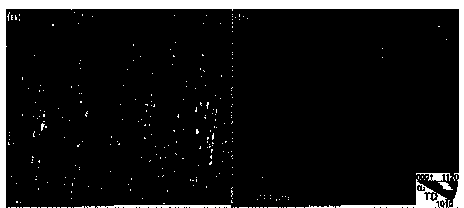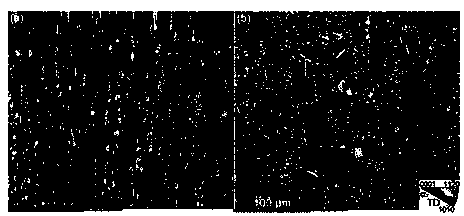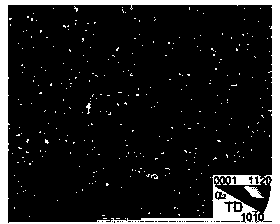Preparation method for gamma-TiAl alloy fine fully lamellar microstructure with preferred oriented lamellar interface
A preferred orientation, full-sheet technology, applied in the field of γ-TiAl-based alloy intermetallic compounds, can solve problems such as poor plasticity at room temperature, and achieve the effects of less difficulty in processing and assembly, less anisotropy of mechanical properties, and small grain size.
- Summary
- Abstract
- Description
- Claims
- Application Information
AI Technical Summary
Problems solved by technology
Method used
Image
Examples
Embodiment 1- Embodiment 2
[0042] Prepared Ti-47Al-2Cr-2Nb-0.15B alloy, the alloy α phase transition temperature T α It was determined to be 1340°C by metallographic method. The alloy was subjected to sheath hot extrusion deformation at 1300°C, and the extrusion ratios were 8 and 11, respectively. Deformed tissues such as figure 2 As shown, in the corresponding tissue α 2 Opposite pole figure such as image 3 shown. It can be seen from the figure that in the deformed tissue α 2 The phase grains are fine and uniform, equiaxed grains, α in the structure 2 The phase has a strong silk texture. The deformed structure after single-phase solution treatment at 1340°C for 5 minutes is as follows: Figure 4 It can be seen from the figure that the lamellar interfaces of most grains in the structure are parallel or nearly parallel to the extrusion direction. In this tissue (extrusion ratio is 11) α 2 The reverse pole diagram of the phase is shown in Figure 5 It can be seen from the figure that α 2 The...
Embodiment 3- Embodiment 4
[0044] Prepared Ti-47Al-2Cr-2Nb-0.15B alloy, the alloy α phase transition temperature T α It was determined to be 1340°C by metallographic method. The alloy was subjected to sheath hot extrusion deformation at temperatures of 1250°C and 1340°C, and the extrusion ratio was 8. α in the final deformed tissue and deformed tissue 2 Opposite pole figures are as Figure 6 and Figure 7 shown. It can be seen from the figure that in the deformed tissue α 2 The phase grains are fine and uniform, which are equiaxed grains and lamellar grains respectively. In the structure, α 2 The phase has a strong silk texture. The alloy 1340 ℃ single-phase solid solution treatment structure is as follows Figure 8 It can be seen from the figure that the lamellar interfaces of most grains in the structure are parallel or nearly parallel to the extrusion direction. Table 1 shows the microstructure characteristics of the above-mentioned deformed microstructure and the subsequent α-single-phase s...
Embodiment 5
[0046] Prepared Ti-47Al-2Cr-2Nb-0.15B alloy, the alloy α phase transition temperature T α It was determined to be 1340°C by metallographic method. The alloy was subjected to three-pass near-isothermal forging deformation at 1300°C, 1280°C and 1250°C in sequence, and the final reduction was 65%. α in the final deformed tissue and deformed tissue 2 Opposite pole figures are as Figure 9 and Figure 10 shown. It can be seen from the figure that in the deformed tissue α 2 The equiaxed grains are fine and uniform, and most of the α 2 The phase direction is parallel to the pressing direction. The alloy 1340 ℃ single-phase solid solution treatment structure is as follows Figure 11 It can be seen from the figure that the lamellar interfaces of most grains in the structure are vertical or nearly perpendicular to the direction of pressing. Table 1 shows the microstructure characteristics of the above-mentioned deformed microstructure and the subsequent α-single-phase solution-...
PUM
| Property | Measurement | Unit |
|---|---|---|
| particle size | aaaaa | aaaaa |
| yield strength | aaaaa | aaaaa |
| heat deflection temperature | aaaaa | aaaaa |
Abstract
Description
Claims
Application Information
 Login to View More
Login to View More - R&D
- Intellectual Property
- Life Sciences
- Materials
- Tech Scout
- Unparalleled Data Quality
- Higher Quality Content
- 60% Fewer Hallucinations
Browse by: Latest US Patents, China's latest patents, Technical Efficacy Thesaurus, Application Domain, Technology Topic, Popular Technical Reports.
© 2025 PatSnap. All rights reserved.Legal|Privacy policy|Modern Slavery Act Transparency Statement|Sitemap|About US| Contact US: help@patsnap.com



